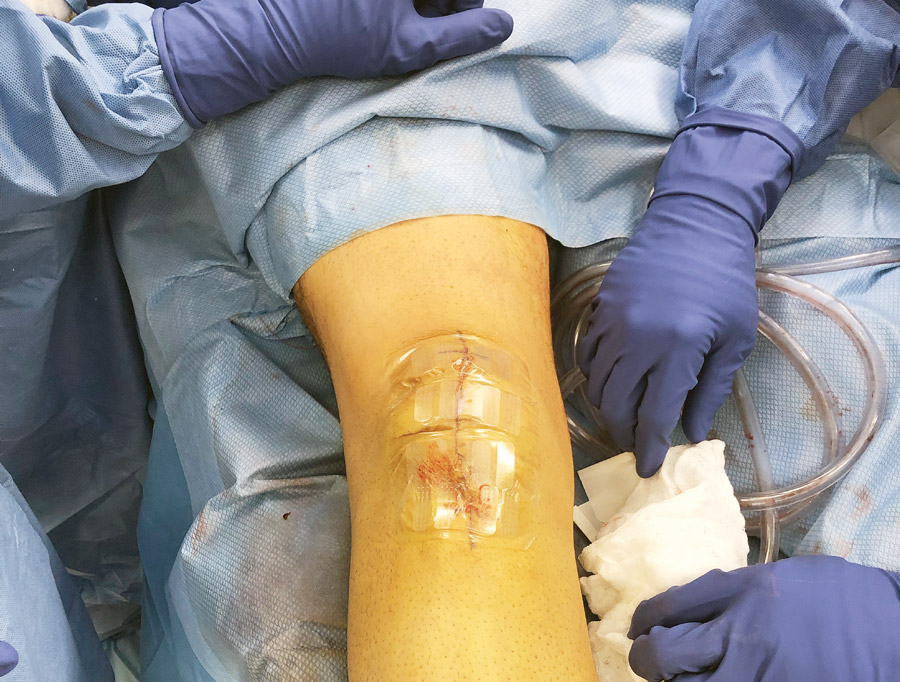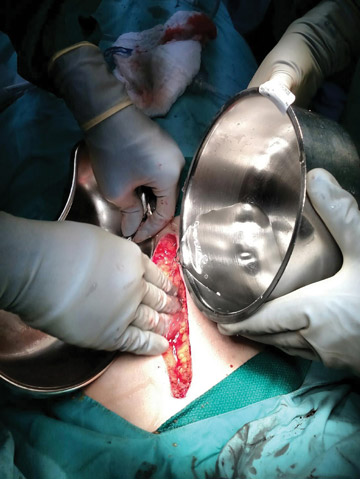Surgical incisions create openings and opportunities for the trillions of bacterial cells that live inside of the body, so efforts to prevent post-op infections shouldn't end until wounds are properly cleaned, closed and covered. Depending on the type of incision, surgeons can opt for any of the tried-and-true closing methods — sutures, staples, skin adhesives, hybrid devices and Steri-Strips. Regardless of the method they choose, preventing surgical site infections (SSIs) must be priority number one.
- Home
- Article
Keys for Infection-Free Wound Care
By: Renee Khalar
Published: 3/9/2021
Preventing SSIs and keeping scarring to a minimum are important aspects of proper patient care.

Important last step
One key to preventing SSIs is a tightly layered wound closure that doesn't leave open areas below the skin surface that can turn into abscesses and, eventually, infections. Surgeons performing a layered closure deep inside the body almost always use sutures, according to Matthew Regulski, DPM, a foot and ankle surgeon and medical director at the Wound Care Institute of Ocean County in Toms River, N.J. Dr. Regulski says surgeons often use nonabsorbable sutures when securing structures that they want to hold together for a long time, such as tendons. Absorbable sutures that can take up to six months to dissolve are also available, he says.
The closing methods your surgeons use must be strong enough to completely close each layer of the wound until it's completely healed. "Infection prevention really starts at the deeper tissue layers," says Jon Minter, DO, an orthopedic surgeon in Alpharetta, Ga., who specializes in advanced surgical management of hip and knee arthritis. "And some of the sutures available now are antibactericidal, which are fantastic because they inhibit bacterial growth."
Another key component of wound care is proper irrigation. "The classic statement is, 'the solution to pollution is dilution,'" says Dr. Minter. "Irrigation of the wound is part of the continuum of care in most surgical cases because foreign debris or planktonic bacteria can be removed through the use of irrigating solutions."
Irrigating the wound during a layered closure is vital to flush out any bacteria debris; otherwise, the bacteria will pool and create an abscess and an infection. For these reasons, Dr. Minter suggests a standard approach to wound irrigation should be considered for even the most routine surgical procedures as part of an overall antisepsis care program in the OR.
"We're seeing enhancement in some of the wound irrigates that are available," he notes. "They're key in terms of reducing infection, which is going to allow for greater healing."
Dr. Regulski also praises the benefits of proper wound irrigation. "In the old days, we used saline, which has no effect on bacteria or biofilm, or a diluted betadine solution, which is toxic to healing cells and bone tissue," he explains. "Newer irrigating options destroy biofilm, which is resistant to so many things, without harming good tissue. So, you can irrigate the wound as you're completing a layered closure to prevent infections in high-risk patients."
In addition to closing technique and irrigation, applying wound gel and sterile adherent dressings to the incision helps to prevent bacteria from getting in. "A lot of the dressings we use now are silver impregnated, which are very inhibitory to bacteria, so we apply them to create a sterile environment," says Dr. Minter. "We'll leave them on our outpatient hip and knee patients for five to seven days, and by that time the wound has healed up quite nicely. These dressings also allow patients to shower without getting the wound wet."
A permanent reminder

No patient goes into surgery hoping they leave with a thick red scar. They almost expect their surgeon to perform the procedure in a way that will leave them with minimal scarring — or no scar at all. Even if patients say they don't care about the aesthetics of their surgery, their tune often changes once they see a scar. There's no doubt the scarring component plays a major role in patients' overall satisfaction with their surgical experience.
In other words, regardless of how impressive the outcome of surgery, patients who are left with a big, ugly scar are going to associate it with the time spent at your facility. Employing tight wound-closure techniques not only helps to reduce infections, it leads to minimal scarring.
"We often perform subcuticular stitching, which involves putting absorbable sutures just underneath the skin, and then use skin glue so the result is a very thin scar," says Dr. Regulski. "Or we can perform a subcuticular closure with nonabsorbable suture. You leave the suture in place for a couple of weeks, then pull it out once the tissue is healed. This technique produces very little scarring."
In terms of healing, the normal inflammatory response takes three to four days. So, if a patient sees their incision a few days after surgery, it's going to be red, hot and swollen. Dr. Regulski says he doesn't see his patients for five to six days after surgery to allow the normal inflammatory response time to dissipate. "Surgical centers, however, should be calling the patient the next day to see how they're feeling and to make sure the bandage is clean, dry and intact," he says.
'The best possible results'
No patient should walk away from a procedure they willingly signed up for with a separate medical problem — an infection that can even prove fatal in a small number of cases. The mortality rate of SSIs is 3%, and 75% of them are directly attributable to the infection, according to the Centers for Disease Control and Prevention (CDC).
Infection prevention really starts at the deeper tissue layers.
— Jon Minter, DO
Plus, SSIs are estimated to cost the nation's healthcare system $3.3 billion a year to treat. With HOPDs and ASCs always looking for ways to cut costs, preventing an SSI is one the greatest potential cost-saver they can employ.
If one of your patients does develop an SSI, they're going to be extremely unhappy with their surgeon and your facility. They might have no problem expressing their dissatisfaction with the surgical experience and outcome on social medial for the whole world to see. "The surgeon didn't tell me I'd have a painful scar" is not something you want to see posted on your facility's Facebook page.
That's why it's important to educate patients on what they should expect as their wound heals as well as relevant information on post-op wound care (including the supplies they'll need and signs of infection to look for). This should take place during clinic appointments prior to surgery because most patients are too nervous or too sedated to remember what they're told right before or after procedures. Dr. Regulski is a big believer in giving his patients the long version of every potential problem that could take place. "My list of complications has about 40 on it, so patients know exactly what could happen," he says.
With outpatient facilities performing more elaborate procedures, preventing just one surgical site infection can save lives and a lot of money. Especially, when you consider that patients with SSIs are twice as likely to die than other surgical patients and are five times more likely to be readmitted into the hospital. Ultimately, infection-free surgical care with minimal scarring leads to happier patients.
"The outpatient setting is a competitive space," says Dr. Minter. "You want to make sure you're delivering the best possible results for your patients." Proper wound care is a major component of that goal. OSM
.svg?sfvrsn=be606e78_3)
.svg?sfvrsn=56b2f850_5)